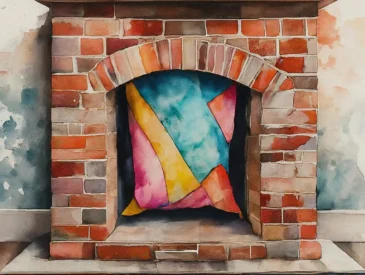Fireplaces, especially gas ones, may seem like straightforward appliances. You turn them on and enjoy the warmth. However, the smoke and ash produced need a path to escape, and that’s where the flue comes into play.

But should you keep the flue open on your gas fireplace? Yes, the flue of your gas fireplace should be open during and slightly after lighting your pilot light. An open flue ensures proper ventilation,
which helps eliminate many safety risks. If the ember bed is completely extinguished, you can close the flue to retain heat, but otherwise, it should remain open.
There are various scenarios in which your gas fireplace may have a specific type of flue or, in some cases, might not require one at all. However, in the majority of cases, a flue is necessary for gas fireplaces. So, read on to become an expert on all things related to flues!
Should You Open the Flue on a Gas Fireplace?
Flues should always be kept open, as they are responsible for ventilating your fireplace. Closing the flue while lighting a fire can lead to smoke and fumes entering your home.
Therefore, it’s crucial to keep it open, especially if you frequently use your fireplace. The only exception to this is if you have ventless gas logs, which are specifically designed to burn gas cleanly with minimal exhaust.
While keeping your flue open at all times is highly recommended, we understand that it’s similar to having a small hole in your roof. If you choose to close your flue, ensure all embers are completely extinguished.
If something is still burning, it will produce smoke and fumes, which you don’t want in your home. Once all the embers are out, it’s perfectly safe to close the flue.
Closing the flue enhances heat retention as there’s no longer an airway to the outside. This keeps both the heat generated by your home heating system and the heat from your fireplace inside,
resulting in a warmer room. Additionally, it helps save money on heating expenses!
Another way to trap heat inside the fireplace is by closing the doors. This allows you to leave the flue open while cutting off the airway.
While keeping the flue closed when the fireplace is not in use helps retain heat, keeping the damper closed while the fireplace is in use won’t make your gas logs emit more heat. Gas fireplaces are designed more for ambiance than as primary heat sources.
What Is a Flue?
The flue is the passage through which smoke escapes while a fire is burning. Inside the flue, you’ll find the damper for your fireplace. The damper controls the airflow in and out of your chimney.
A flue is a crucial component, and almost every fireplace/appliance has its own. Its primary function is to direct smoke away from your home and into the chimney.
How Do You Open the Flue on a Gas Fireplace?
Now that you know your flue should be open, you might be wondering how to do it. But before we get into that, you should check whether your flue is already open or not. Here’s how:
1. Is there a draft? If the flue is open, and you place your hand above the fireplace, you should feel a breeze from the chimney.
2. What do you see? Use a flashlight to look up your chimney. If you see a barrier, the damper in your flue is closed. If you can see upwards, the flue is open.
3. Is there smoke? Light your fireplace. If an unusual amount of smoke enters your house, your flue is closed, obstructing ventilation. If it’s open, the smoke will exit through the chimney. Do this carefully, preferably with a small fire, to avoid filling your house with smoke.
Related: smoke shelves
Once you’ve determined if your flue is open, here’s how to open it if necessary. There are several styles of flue fittings, so check to see which controls you have:
- Metal rod: This is a traditional damper. The rod will have a push or lift function. Push or lift it as far as you can to open the flue.
- Rotary knob: Turn the knob as far clockwise as possible to open it.
- Metal chain: If you have a top-mount flue, pull down on the chain. If it springs back up, the flue is already open.
Do All Gas Fireplaces Have a Flue?
Most gas fireplaces have a flue as it’s a required fail-safe mechanism in most states. Flues ventilate the fireplace, ensuring no smoke or fumes enter your home.
Many modern models also include a keep-open device that prevents the flue from fully closing, ensuring it always functions correctly. You will have a flue if you have either a direct or natural-vent gas fireplace.
- Direct-vent gas fireplaces: These require a flue and damper system to function, allowing air to be vented between your fireplace and the outside. This prevents waste air from mixing with the air you breathe.
- Natural vent gas fireplaces: These use chimneys to draft smoke outside and typically sit within masonry fireplaces. It’s standard for natural vents to always be open, thus not necessarily needing a damper inside the flue. However, if they do have a damper, it should always be left open inside the chimney.
Having a ventless, fluidless, or vent-free gas fireplace. These are designed to be safe for indoor use without the need for flue ventilation.
They burn gas so cleanly that only carbon dioxide and water vapor are produced, with no carbon monoxide. Sometimes, an external air vent can be useful to ensure adequate oxygen levels.
Ventless fireplaces are more versatile and can be placed anywhere in the house without the need for a flue.





